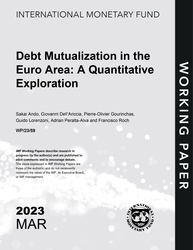
Debt Mutualization in the Euro Area: A Quantitative Exploration
Debt Mutualization in the Euro Area: A Quantitative Exploration
READ MORE...
Volume/Issue:
Volume 2023
Issue 059
Publication date: March 2023
ISBN: 9798400234309
$20.00
Add to Cart by clicking price of the language and format you'd like to purchase
Available Languages and Formats
| English |
Prices in red indicate formats that are not yet available but are forthcoming.
Topics covered in this book
This title contains information about the following subjects.
Click on a subject if you would like to see other titles with the same subjects.
Exports and Imports , Economics- Macroeconomics , Public Finance , Economics / General , Sovereign Debt , Debt Mutualization , Debt Assumption , Convenience Yield , Safe Assets , , debt mutualization equivalent , mutualization proposal , EDMA debt , Debt reduction , Fiscal consolidation , Debt sustainability analysis , Fiscal stance , Europe
Also of interest
Summary
This paper explores the feasibility of an idea proposed first by the German Council of Economic Experts in 2011 and revisited by Italian and French authorities in 2021: the one-off mutualization of some European legacy debt through the creation of a European Debt Management Agency (EDMA). The paper does not argue in favor or against these proposals or make a proposal of its own. Rather it outlines a conceptual framework that can be used to quantify the contours of mutualization proposals and draws lessons from the debt assumption in the United States in 1790. The framework suggests that by capitalizing the convenience yield on European-wide safe assets, the EDMA could issue up to 15 percent of euro area GDP, helping to put national debts on a sounder trajectory. The analysis suggests that, without mutualization, some euro area countries are likely to experience decreasing debt-to-GDP ratios over the forecast period. This is not the case for Belgium, Finland, France, Italy, and Spain, where further fiscal consolidation would be needed. For these countries, we consider the effects of a debt mutualization equivalent to 26 percent of their GDP. For Italy, this operation alone is enough to ensure a decreasing debt-to-GDP path. For the others, the news is more mixed: while the additional fiscal consolidation is smaller, 1.3 to 2.3 percent of GDP are still required to reduce debt with 95 percent probability.
Copyright © 2010 - 2026
Powered by:
AIDC



